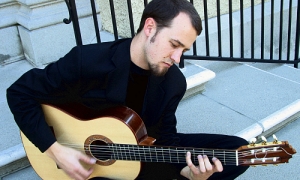Gyan Riley: Playing Jackson Pollock
On February 4th 2010 at Merkin Concert Hall, Gyan Riley will be performing an original score to accompany a series of short animations by the artist, music collector and experimental filmmaker Harry Smith.

“It’s from a collection called `Early Abstractions,’” Riley explained. “They’re from the mid-Forties to the mid-Fifties, but I think they’re pretty far ahead of their time. It’s brilliant stuff. A lot of it is very rugged in nature, especially compared to what we’re used to today—the animations, especially, that we see today are very refined. His work is really coarse in an incredibly beautiful way. Often he’ll use shapes as subject material. Circles, for example. He’ll create different presentations and sequences involving circles.”
Riley began the scoring process by watching “everything I could find on YouTube and everything I could get from the [Harry Smith] Archive on DVDs.”
He ended up selecting and scoring sections that at first sight repelled him.
“Some are so coarse that I was almost put off by them, but as I watched them over and over I grew to love them.”
Once he had picked his visual material, he started to consider the music, starting with the basic feel and color he wanted to create.
“I’m primarily a classical guitar player, but I decided not to go with the classical guitar–it didn’t seem to go very well with the visual. I decided to use an electric guitar with a variety of effects boxes, to give the sound a more abstract feel.”
The opening section, he explained, involves a lot of screen static. “That spoke to me in a certain way. It didn’t feel right to use a plain, clean guitar sound. I wanted something corresponding to static. So I used three or four different effects boxes—some delays, some phasing, some loop sampling.”
And that’s what he’ll take on stage when he performs. “Everything will be me,” he laughed. “No pre-recorded material!”
That, and his score. To call it a score, however, may give a misleading impression of what he has created, and is still creating. Part basic score and part springboard for improvisation, it looks less like Bach than, say, Jackson Pollock.
“It’s about two pages long, incredibly messy and full of junk. It’s got a few notes here and there, and a few rhythms, a few illegible words, and down at the bottom my grocery list and a few coffee stains.”
Even for a guitarist as adventurous as Riley, the performance at the New York Guitar Festival presents new challenges.
“I’ve never performed a live sound track before. It’s incredibly challenging. It’s a bit like working with an orchestra and a conductor and looking at a screen at the same time. I’m looking at the screen, at the score, I’m working the effects with my
feet and my hands, occasionally I have to look at the guitar and at its controls…. With a classical guitar, everything is in your hands and right there in front of you. That’s the beauty of it. With this I’m multitasking so hard I’m afraid my head will explode.”
It’s still too early to know whether he’s satisfied with the work.
“I really have no idea. Some things I’m happy with, and some things I’m still working on very hard. And the day after tomorrow I have to go on tour right up until a week before I leave for New York, so I’m going to be putting in a lot of studio time over those few days!”
•••
By Tim Brookes
(Tim is the author of Guitar: An American Life. He blogs regularly on guitar and other matters at www.timbrookesinc.com)
